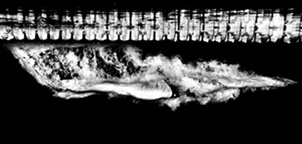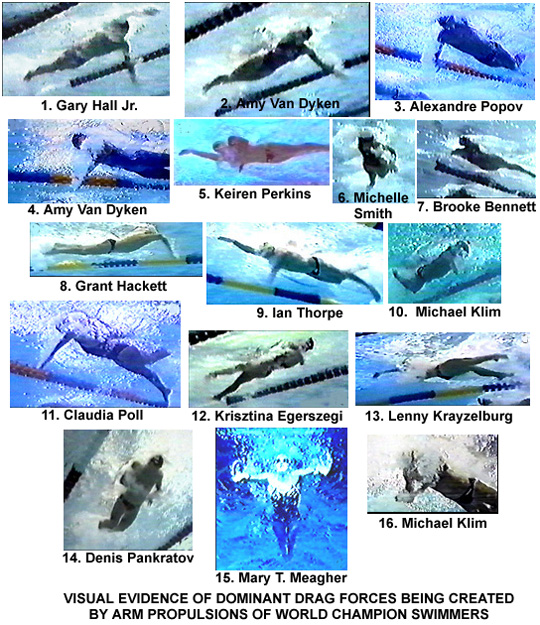

STILL MORE ON DRAG VERSUS LIFT PROPULSION IN SWIMMING
Support is rising to refute the belief that lift forces and Bernoulli's Principle are significant contributors and reasons for propulsion in swimming strokes. In academic circles Sanders (1997a, 1997b) has confirmed that when effective propulsion is created, the hand primarily develops a drag force component even when it is pitched at the appropriate angle to produce the greatest lift force component. Dr. Ernie Maglischo, in his opening address to the 1998 American Swimming Coaches Association Conference in Atlanta, made compelling arguments to support the contentions that: (a) while a hand/arm is underwater not every movement is propulsive, and (b) lift forces are minor and overshadowed by drag forces when propulsion, and consequential acceleration of the swimmer, exists. These descriptions support the contentions of Rushall, Sprigings, Holt, and Cappaert (1994) that drag force is the most important element of propulsion in swimming movements.
Better interpretations of what is seen in swimmers' actions is needed. For too long coaches have used non-evidenced-based "lift" theory to "explain" what swimmers are doing. Exaggerated curved paths of movement have been taught supposedly so that maximum lift is generated. Hand and hand/arm paddles are still used as "beneficial" training aids to assist in these movements even though they cannot develop lift force components greater than drag force components. Frequently, when this contradiction is indicated to coaches it was met with aggressive hostility and/or personal derision ("too controversial").
Not all movements underwater can be or are propulsive (accelerative). If a swimmer is not accelerating, then he/she will be mainly slowing down. At the commencement and finish of all forms of stroking there are periods of time when acceleration cannot be produced. It behooves a coach to minimize the time and extent of movements in these phases when the role of the arm is one of being repositioned to get to a position of effective force production. When that position is achieved, acceleration results from the two force components: lift and drag. Because of the shape of the hand, forearm, and upper arm, and the low relative velocity of water in all strokes, the drag force component is the only force component that can be dramatically altered. It has long been known that when an elite swimmer is accelerating the greatest, the hand/forearm velocity relative to the water, is least (Wood, 1977). That is, a swimmer does not move the arm through the water but rather, moves the body past a "fixed" arm. A slow-moving or stationary arm in a fluid produces very little lift.
However, to return to the main point of this forum, drag forces need to be emphasized and lift forces ignored when instructing stroke technique at all levels. Many will claim that "scientific proof" has to be developed to substantiate such a proposal. Occasionally, there are times when the demands for scientific validation overlook the obvious. This author believes this is such an occasion. The proof of the influence and production of drag forces has been staring coaches and scientists in the face for as long as swim coaching has existed. It has been so obvious that it has been ignored probably because of its simplicity.
The Carlile Coaches' Forum attempts to substantiate the obvious events in swimming stroking that show drag forces in action.
Understanding what happens in fluid flow. In my biomechanics lectures I use the following illustration. It shows that when a fluid (air or water) flows around an object certain phenomena occur. For this discussion it is turbulence that is important. It represents the consequences of the boundary layer breaking away from the surface of the object. That turbulence is drag resistance and produces forces in the direction of the fluid flow. Such turbulence usually is invisible in air. However, the eddies that comprise the turbulence in water create random light refraction causing a milky white "substance" often called "bubbles" by coaches. Some individuals have even proposed that these "bubbles" are bad and coached swimmers to get rid of them. When turbulence continues from an entry into a fluid bubbles sometimes are involved in the "whiteness." This can be easily seen in the wakes of boats, turbulence from propellers, and the swirls of paddles and oars.

In many circumstances in water, one only needs to look for drag force turbulence and it can be seen.
Below is a picture of Emma Johnson, Australian Olympic finalist, after a dive. Both turbulence and some bubbles are evident. Of particular significance is the almost pure turbulence on the underside of the swimmer. The drag resistance created by this "visible turbulence" retards the forward motion of the swimmer after entering the water. After a dive, the swimmer moves relatively fast and so the visibility factor in the drag resistance is quite high because turbulence is high. Drag resistance/forces can be seen in this example.

When drag forces are overwhelmingly dominant can be seen by the turbulence trailing the hand/arms of swimmers as they develop forces to move through the water. Below are examples of turbulence/drag-force-production in champion swimmers mostly taken from their races. Turbulence can be seen off the propulsive arm(s). In the Lenny Krayzelburg picture there is so much turbulence that the actual arm is obscured as it is changes to extension of the elbow. All pictures are extracted from the How Champions Do It section of the Swimming Science Journal. Each picture is numbered, the number corresponding to the listed swimmer.
Examples of Drag Forces Created by Champion Swimmers

Propulsive drag forces only occur in the propulsive phases of strokes. Those forces can be seen in each of the above captured video frames.
References
Return to Table of Contents for the Carlile Coaches' Forum.
